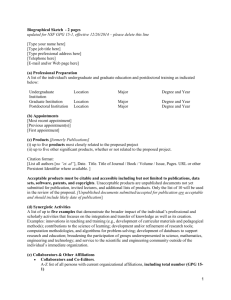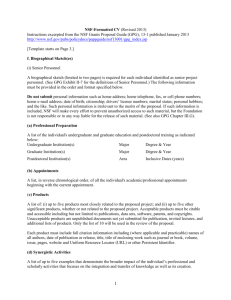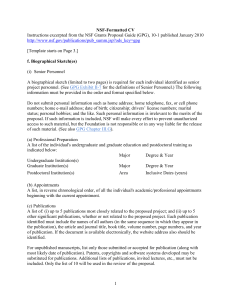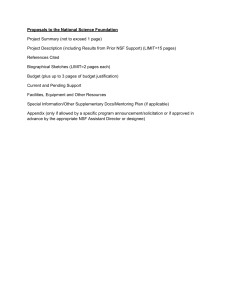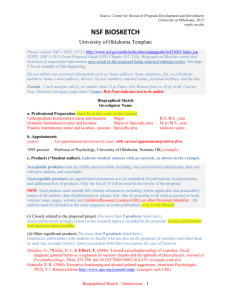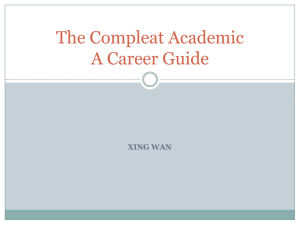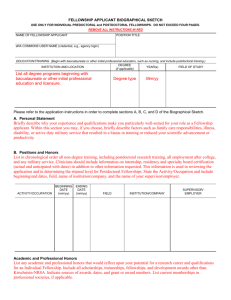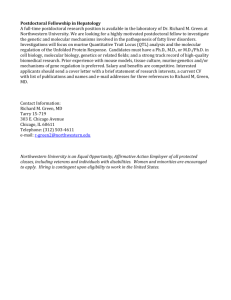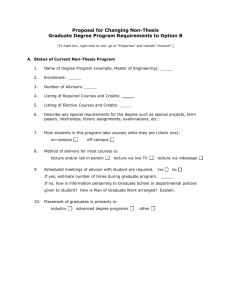Word - Santa Fe Institute
advertisement
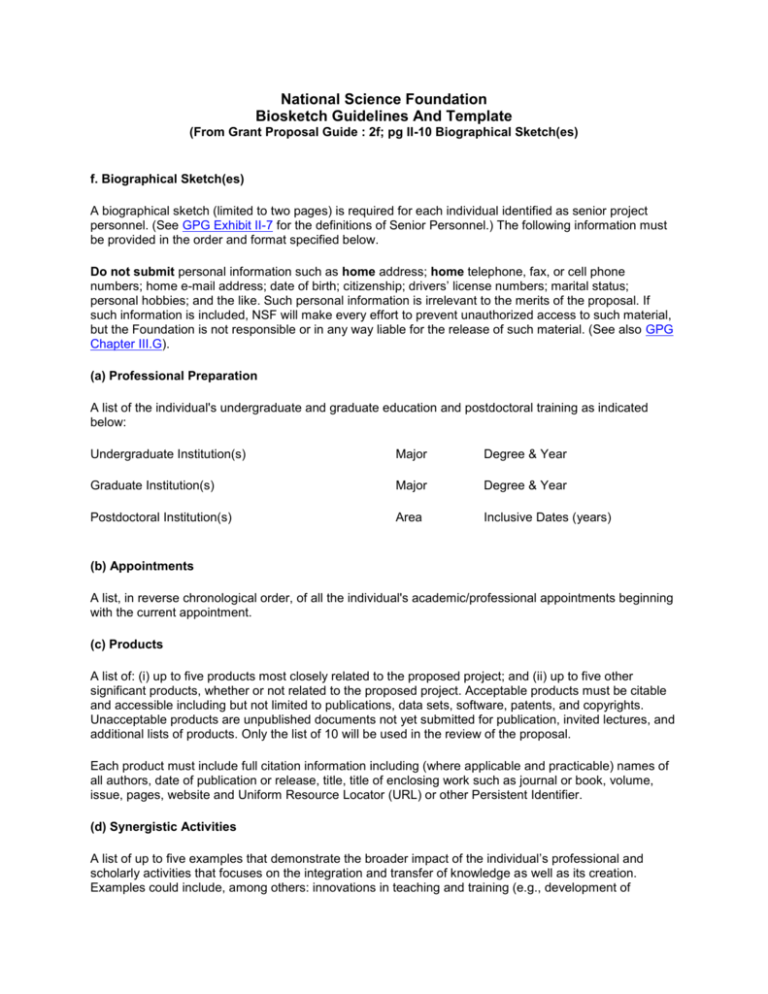
National Science Foundation Biosketch Guidelines And Template (From Grant Proposal Guide : 2f; pg II-10 Biographical Sketch(es) f. Biographical Sketch(es) A biographical sketch (limited to two pages) is required for each individual identified as senior project personnel. (See GPG Exhibit II-7 for the definitions of Senior Personnel.) The following information must be provided in the order and format specified below. Do not submit personal information such as home address; home telephone, fax, or cell phone numbers; home e-mail address; date of birth; citizenship; drivers’ license numbers; marital status; personal hobbies; and the like. Such personal information is irrelevant to the merits of the proposal. If such information is included, NSF will make every effort to prevent unauthorized access to such material, but the Foundation is not responsible or in any way liable for the release of such material. (See also GPG Chapter III.G). (a) Professional Preparation A list of the individual's undergraduate and graduate education and postdoctoral training as indicated below: Undergraduate Institution(s) Major Degree & Year Graduate Institution(s) Major Degree & Year Postdoctoral Institution(s) Area Inclusive Dates (years) (b) Appointments A list, in reverse chronological order, of all the individual's academic/professional appointments beginning with the current appointment. (c) Products A list of: (i) up to five products most closely related to the proposed project; and (ii) up to five other significant products, whether or not related to the proposed project. Acceptable products must be citable and accessible including but not limited to publications, data sets, software, patents, and copyrights. Unacceptable products are unpublished documents not yet submitted for publication, invited lectures, and additional lists of products. Only the list of 10 will be used in the review of the proposal. Each product must include full citation information including (where applicable and practicable) names of all authors, date of publication or release, title, title of enclosing work such as journal or book, volume, issue, pages, website and Uniform Resource Locator (URL) or other Persistent Identifier. (d) Synergistic Activities A list of up to five examples that demonstrate the broader impact of the individual’s professional and scholarly activities that focuses on the integration and transfer of knowledge as well as its creation. Examples could include, among others: innovations in teaching and training (e.g., development of curricular materials and pedagogical methods); contributions to the science of learning; development and/or refinement of research tools; computation methodologies, and algorithms for problem-solving; development of databases to support research and education; broadening the participation of groups underrepresented in science, mathematics, engineering and technology; and service to the scientific and engineering community outside of the individual’s immediate organization. (e) Collaborators & Other Affiliations Collaborators and Co-Editors. A list of all persons in alphabetical order (including their current organizational affiliations) who are currently, or who have been collaborators or co-authors with the individual on a project, book, article, report, abstract or paper during the 48 months preceding the submission of the proposal. Also include those individuals who are currently or have been coeditors of a journal, compendium, or conference proceedings during the 24 months preceding the submission of the proposal. If there are no collaborators or co-editors to report, this should be so indicated. Graduate Advisors and Postdoctoral Sponsors. A list of the names of the individual’s own graduate advisor(s) and principal postdoctoral sponsor(s), and their current organizational affiliations. Thesis Advisor and Postgraduate-Scholar Sponsor. A list of all persons (including their organizational affiliations), with whom the individual has had an association as thesis advisor, or with whom the individual has had an association within the last five years as a postgraduatescholar sponsor. The total number of graduate students advised and postdoctoral scholars sponsored also must be identified. The information in section (e) above of the biographical sketch is used to help identify potential conflicts or bias in the selection of reviewers. See GPG Exhibit II-2 for additional information on potential reviewer conflicts. Template Name Position Institution City, State, zip code Telephone: (xxx) xxx.xxxx Fax: (xxx) xxx.xxxx Email: your@emailaddress.edu PROFESSIONAL PREPARATION Undergraduate Institution(s) Major Degree & Year Graduate Institution(s) Major Degree & Year Postdoctoral Institution(s) Area Inclusive Dates (years) APPOINTMENTS (A list, in reverse chronological order, of all the individual's academic / professional appointments beginning with the current appointment.) 2000 - present 1990 - 1999 1985 - 1989 1980 - 1984 Professor, Santa Fe Institute, Santa Fe, NM, USA Position, Organization, City, Country Position, Organization, City, Country Position, Organization, City, Country PRODUCTS or PUBLICATIONS (i) up to 5 products / publications most closely related to the proposed project For each publication, include the names of all authors (in the same sequence in which they appear in the publication), the article and journal title, book title, volume number, page numbers, and year of publication. If the document is available electronically, the website address also should be identified. For unpublished manuscripts, list only those submitted or accepted for publication (along with most likely date of publication). Patents, copyrights and software systems developed may be substituted for publications. Additional lists of publications, invited lectures, etc., must not be included. Only the list of 10 will be used in the review of the proposal. Other significant publications (ii) up to 5 other significant publications, whether or not related to the proposed project. SYNERGISTIC ACTIVITIES A list of up to five examples that demonstrate the broader impact of the individual’s professional and scholarly activities that focuses on the integration and transfer of knowledge as well as its creation. Examples could include, among others: innovations in teaching and training (e.g., development of curricular materials and pedagogical methods); contributions to the science of learning; development and/or refinement of research tools; computation methodologies, and algorithms for problem-solving; development of databases to support research and education; broadening the participation of groups underrepresented in science, mathematics, engineering and technology; and service to the scientific and engineering community outside of the individual’s immediate organization. Collaborators and Other Affiliations (within the last 48 months): Collaborators and Co-Editors: An alphabetical list of current or past collaborators or coauthors (last 48 months) and co-editors (last 24 months) Name, current organization Graduate Advisor: Name, current organization Postdoctoral Sponsor: Name, current organization Thesis Advisor: A list of all persons (including their organizational affiliations), with whom the individual has had an association as thesis advisor (in the last 5 years) Total graduate students advised: # Postgraduate-scholar sponsor: A list of all persons (including their organizational affiliations), with whom the individual has had an association as a postgraduate-scholar sponsor (within the last 5 years). Total postdoctoral students sponsored: #
